In an era of significant market volatility, investors face the challenge of navigating a landscape marked by unpredictable fluctuations and global economic uncertainties. This article examines the recent trends in major indices like the Dow Jones, the impact of events like the U.S.-China trade tensions, and the influence of Federal Reserve policies.
It also provides strategic insights for investors to adapt and thrive in these turbulent times, highlighting the importance of informed decision-making and portfolio diversification.
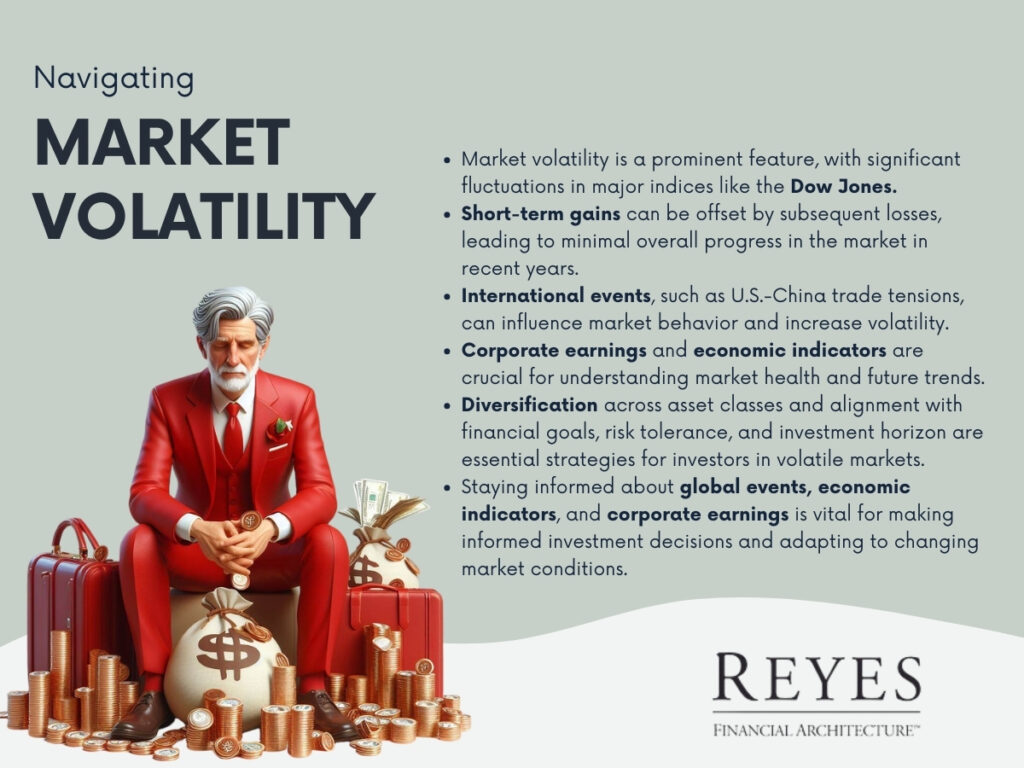
Market volatility has been a prominent feature in recent times, especially in major indices like the Dow Jones Industrial Average. This volatility is highlighted by significant fluctuations, with the market experiencing substantial gains since January, followed by a notable downturn.
For instance, a 5% drop in the Dow Jones over three weeks from late April emphasizes the unpredictable and often rapid changes in market conditions. Such movements are not unusual in the historical context, with previous years witnessing similar, if not more pronounced, corrections.
Despite these short-term fluctuations, a longer-term view presents a different picture. Since January 2018, there has been little overall progress in the market. Investments in major indices during this period have shown minimal growth or even slight declines, demonstrating that short-term gains can often be offset by subsequent losses.
In contrast, more conservative investments like long-term Treasury bonds have yielded more stable returns, underscoring the importance of diversification and risk management.
International developments, such as trade tensions between the U.S. and China, play a significant role in influencing market behavior. The escalation of tariffs and the ensuing uncertainty can lead to increased market volatility. These geopolitical issues can affect investor sentiment, disrupt global supply chains, and impact the financial performance of companies, both domestically and internationally.
Corporate earnings are a critical indicator of market health and economic conditions. A decline in earnings, such as the transition from peak earnings to lower levels, can signal underlying economic challenges. These changes in corporate profitability are crucial for investors to monitor, as they can provide insights into future market trends and economic directions.
The Federal Reserve's monetary policies significantly affect the financial markets. A shift in the Fed's approach, from increasing to potentially decreasing interest rates, can have wide-reaching implications. Such policy changes can influence consumer spending, business investments, and overall economic growth, reflecting the Fed's response to broader economic trends.
In a volatile market environment, having a robust investment strategy is essential. Diversification across asset classes can help mitigate risks associated with market fluctuations. It is also important for investors to align their strategies with their individual financial goals, risk tolerance, and investment horizons.
Staying informed about global events, economic indicators, and corporate earnings is vital for understanding market movements. This knowledge can assist investors in making informed decisions and adjusting their strategies in response to changing market conditions.
The current financial landscape, marked by volatility and unpredictability, demands a careful and informed approach from investors. Understanding the drivers of market movements and maintaining a diversified investment portfolio are key to navigating these challenging times.
By staying informed and adapting to changing market conditions, investors can better position themselves to achieve their financial objectives in a dynamic economic environment.
Check out this week's show which highlights getting back into the market. David covers historical changes in stocks and bonds, and how to protect your investments.
In an ever-changing financial landscape, understanding the nuances of retirement planning is more important than ever. This article delves into the critical aspects of retirement investment strategies, highlighting the importance of savvy planning, learning from market trends, and adopting effective investment approaches. It aims to equip readers with the knowledge and tools needed to navigate the complexities of building a secure and prosperous retirement.

Retirement planning is a critical aspect of financial well-being. A disturbing statistic reveals that approximately 95% of individuals are either financially dependent or in poor financial shape by age 65. This underscores the necessity of a well-thought-out retirement strategy to ensure financial stability.
Investing wisely is integral to retirement planning. The aim is to develop a portfolio that not only grows wealth but also provides a reliable, lifelong income stream. Effective retirement planning involves educating oneself and utilizing the right tools to create a solid financial future.
The financial market is known for its volatility, as seen in the fluctuating fortunes of various market sectors. For instance, the 1990s were a prosperous era for the stock market, but this was followed by a period of stagnation from 2000 to 2013. These fluctuations highlight the market's unpredictable nature.
Investment strategies are often influenced by human emotions like fear and greed, leading to impulsive decisions. This is particularly evident in volatile markets, where investors may buy high and sell low. Recognizing and mitigating these biases is crucial for successful long-term investing.
Regularly assessing your investment portfolio is key to aligning it with your retirement goals. This involves evaluating risk tolerance, the fee structure, and the overall effectiveness of your investments.
For retirement planning, the focus should shift from aggressive wealth growth to ensuring a sustainable income. This involves aiming for consistent, moderate returns, typically in the 5 to 10 percent range, rather than chasing high-risk investments.
Professional financial advisors can offer insights into optimizing your retirement portfolio. They can conduct comprehensive reviews to identify potential improvements, ensuring your investments align with your retirement objectives.
Retirement planning is complex but crucial for a secure future. Understanding market dynamics, being aware of the psychological aspects of investing, and seeking expert advice can lead to a well-rounded and effective retirement strategy. The goal is to ensure a comfortable retirement, free from financial worries, by making informed and strategic investment decisions.
Check out this video to learn more about the highly successful model David has infused into his planning process
In the realm of investment strategies, one of the more intriguing approaches is the endowment model, notably employed by large institutions like university endowments. This model, championed by figures like David Swensen of Yale University, offers unique insights for individual investors, especially those planning for retirement.
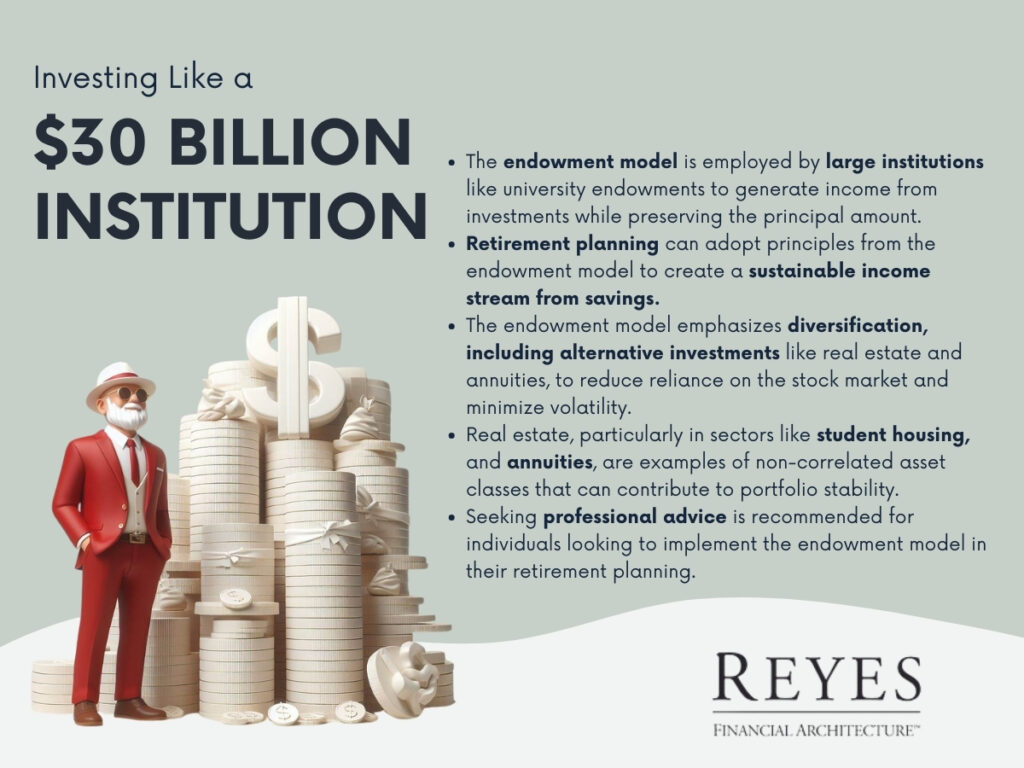
At its core, an endowment is a financial asset, like a fund, held by institutions such as universities. It’s made up of donations that are invested to generate income for the institution. The principal amount generally remains intact while the income supports various expenses.
The Yale endowment, under Swensen's management, became a hallmark of this approach. Yale’s strategy was not just successful but also revolutionary in how it diversified investments beyond the traditional stock and bond portfolio. This diversification aimed to achieve steady returns while minimizing risks.
Retirement planning can be akin to managing an endowment. In both cases, the goal is to create a sustainable income stream from a large pool of savings. The typical recommendation for endowment funds is to aim for a 5% annual distribution. This figure interestingly aligns with the retirement income strategies suggested by many financial planners.
However, a critical difference lies in the investment approach. Traditional retirement portfolios often focus heavily on stocks and bonds. In contrast, the endowment model advocates for a more diversified portfolio including alternative investments.
The endowment model’s success largely stems from its inclusion of alternative investments. These can range from private equity and hard assets like real estate to even more niche options like annuities. For instance, Yale’s portfolio in 2001 included a significant portion in hard assets, primarily real estate, alongside a smaller proportion in domestic and foreign equities.
This diversification strategy not only reduces reliance on the stock market but also potentially smoothens out returns, reducing volatility. The objective is to create a portfolio that can withstand market downturns better and provide more consistent returns over time.
Real estate, especially in sectors like student housing, is a prime example of an alternative investment that can offer stable returns. Properties near major universities, such as USC, Notre Dame, or Northwestern University, can provide a steady income stream, often with tax advantages.
Annuities are another diversifier in this model. While not directly linked to stock or bond markets, they can provide a steady income, adding another layer of stability to a retirement portfolio.
One of the key strengths of the endowment model is its use of non-correlated asset classes. Investments like real estate or annuities don’t necessarily move in tandem with the stock or bond markets. This non-correlation can significantly reduce the portfolio's overall risk.
For individual investors, adopting an endowment-like strategy means moving beyond the conventional wisdom of a stock-and-bond-dominated portfolio. It involves exploring and investing in a variety of asset classes. However, this approach requires careful planning and a thorough understanding of each investment type.
Given the complexity of this investment strategy, seeking professional advice is prudent. Financial advisors with experience in the endowment model can provide valuable insights and help tailor a portfolio that suits an individual’s retirement goals and risk tolerance.
The endowment model, inspired by the strategies of large institutions like Yale University, presents an innovative approach for individual investors, especially those in retirement planning.
Its focus on diversification across various asset classes aims to provide a balanced investment portfolio that can weather market volatility and generate sustainable income. While it may require stepping out of the traditional investment comfort zone, the potential for a more stable and robust retirement income is an enticing prospect for those willing to explore beyond stocks and bonds.
Check out this video to get some insight into David's personal story which lends to the purpose in his passion to help his clients achieve retirement success.
The world of retirement planning is deeply influenced by the personal experiences and histories of those who navigate it. One such journey, devoid of specific names but rich in lessons and insights, offers a valuable perspective on how early life experiences and family histories can shape professional philosophies in financial planning.

The story begins with a young individual, whose life was significantly impacted by their parents' divorce at the age of two. Raised by a single mother with two other children, this person found solace and guidance in the care of their grandparents. These formative years spent with grandparents in a small town provided foundational life lessons and values.
One grandparent, a dedicated employee at a major company like Sears Roebuck, which narrowly escaped bankruptcy, served as an emblem of resilience and adaptability. This grandparent's profession as a television repairman represented a now-obsolete trade, reflecting a bygone era of technological simplicity and hands-on skill.
The grandparent's investment in company stock, such as Sears, showcased the importance of financial involvement and awareness. This early exposure to stock investments and the significance of pension plans left a profound impact on the young individual, instilling a keen interest in financial planning and investment.
Despite modest means, the grandparent exemplified fiscal prudence and the virtue of saving, owning a home outright, and living within one's means. These characteristics were not just survival strategies but were also foundational principles that would later inform a career in financial planning.
A turning point in this narrative was the grandparent's diagnosis with dementia, leading to significant healthcare expenses that eventually depleted their savings. This transition to relying on Medicaid, a program necessitating minimal personal assets, highlighted the financial vulnerabilities faced in old age.
The family's subsequent struggle with a lien on their property due to Medicaid benefits underscored the complexities and challenges of elder care and its financial implications. This experience, occurring at the onset of the individual’s career in financial planning, was a catalyst for a deeper understanding of elder law and financial protection strategies.
These personal experiences with family financial challenges directly influenced the individual's approach to retirement planning. Observing first-hand the impact of medical expenses and the necessity of financial preparedness in later life, the individual adopted a philosophy emphasizing the protection of capital, its growth, and the generation of sustainable income from it.
This approach was further informed by the mindset of the "depression babies" generation, known for their skepticism towards banks and cautious approach to market investments. This background instilled a sensitivity towards clients who value security and stability in their financial planning.
This narrative, while not tied to a specific individual, illustrates how personal experiences can profoundly shape professional approaches in fields like financial planning. It's a poignant reminder that behind the technical aspects of financial advising are human stories, experiences, and histories that influence and guide the strategies and advice offered by professionals in this field.
In recent times, the financial markets have been characterized by significant volatility and unpredictability, often leading investors to experience what is popularly known as the FOMO (Fear of Missing Out) Market. This term aptly encapsulates the anxiety and urgency that investors feel in the face of rapidly changing market conditions, driven by the fear of missing out on potential gains.
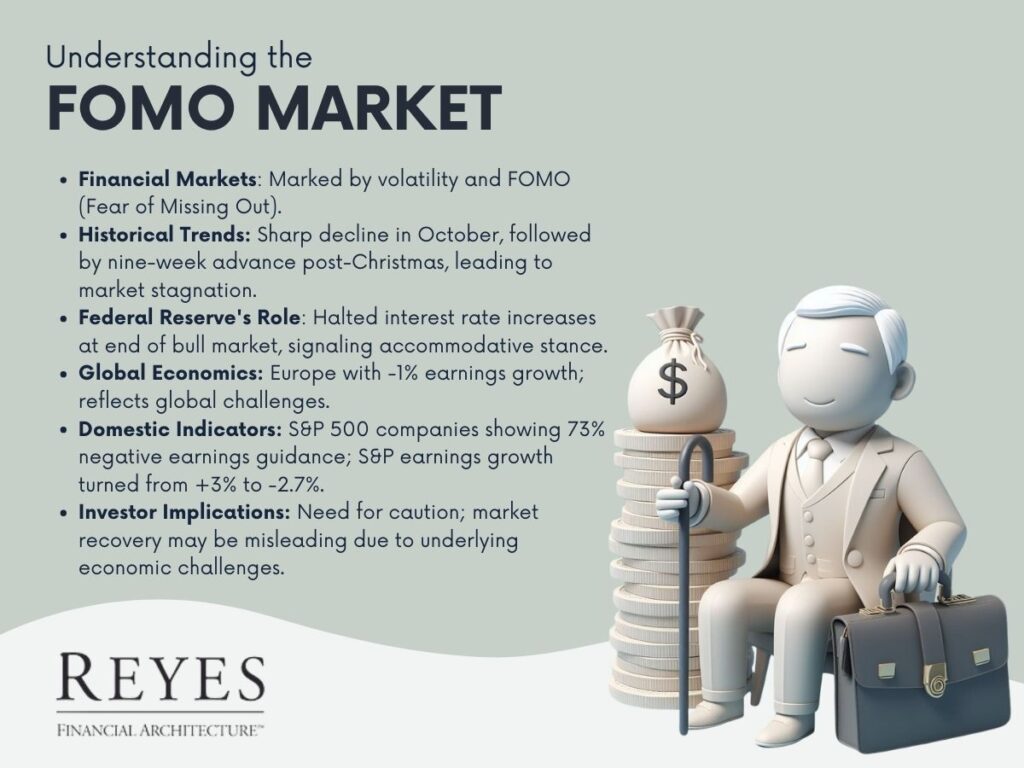
Historically, October of the previous year marked one of the worst performances since 1931, followed by a nine-week continuous advance in the market post-Christmas. This pattern of a sharp decline followed by a rapid ascent has essentially led to a stagnation in market progress over the past year and a half.
The last quarter of the year saw the market in a precarious position, facing challenges from various fronts. However, the Federal Reserve's intervention played a pivotal role in altering this trajectory. The Fed's decision to halt interest rate increases towards the end of a bull market was an unprecedented move, breaking away from traditional monetary policy patterns. This cessation is particularly notable as the market technically entered a bear phase, with a 20% drop from its peak.
The Federal Reserve's actions are crucial in understanding market dynamics. Typically, the Fed raises interest rates to curb inflation and stabilizes the economy, but in this case, they chose a different path. By not increasing rates, the Fed essentially signaled a more accommodative monetary stance, which historically tends to boost market confidence and investment.
Globally, Europe exhibited negative earnings growth in the last year, with a decline of about 1%. This is significant as it reflects broader economic challenges beyond the United States. In the domestic context, nearly all S&P 500 companies have reported their earnings, with a staggering 73% providing negative earnings guidance. This indicates a pessimistic outlook for the future, with expectations of performance being worse than the present.
The S&P earnings growth, which was estimated at 3% in December, has now turned negative, standing at -2.7%. This downturn is particularly stark, considering the record-high earnings growth witnessed in 2018.
These market conditions underscore the need for caution among investors. The rapid recovery of the markets from recent losses might create an illusion of stability and growth. However, the underlying economic indicators suggest otherwise. The volatility is likely to persist, and it's crucial for investors to be prepared for this uncertainty.
Investors are advised to develop a comprehensive understanding of the risks associated with their portfolios. This involves not only a keen awareness of market trends but also a thorough assessment of individual investment objectives, risk tolerance, and long-term financial goals.
In conclusion, navigating the FOMO Market requires a balanced approach, blending caution with opportunity. Understanding the broader economic context, staying informed, and aligning investment strategies with individual risk profiles are key to successfully managing investments in these volatile times. Investors should remain vigilant, adaptable, and informed to make the most out of the opportunities that arise, while safeguarding their investments against potential downturns
Financial planning is a critical aspect of securing one’s financial future, especially when approaching retirement. An effective strategy often involves a detailed, client-focused process, typically structured into three key meetings. This approach is designed to be deeply personalized, reflecting the unique financial circumstances and goals of each individual.
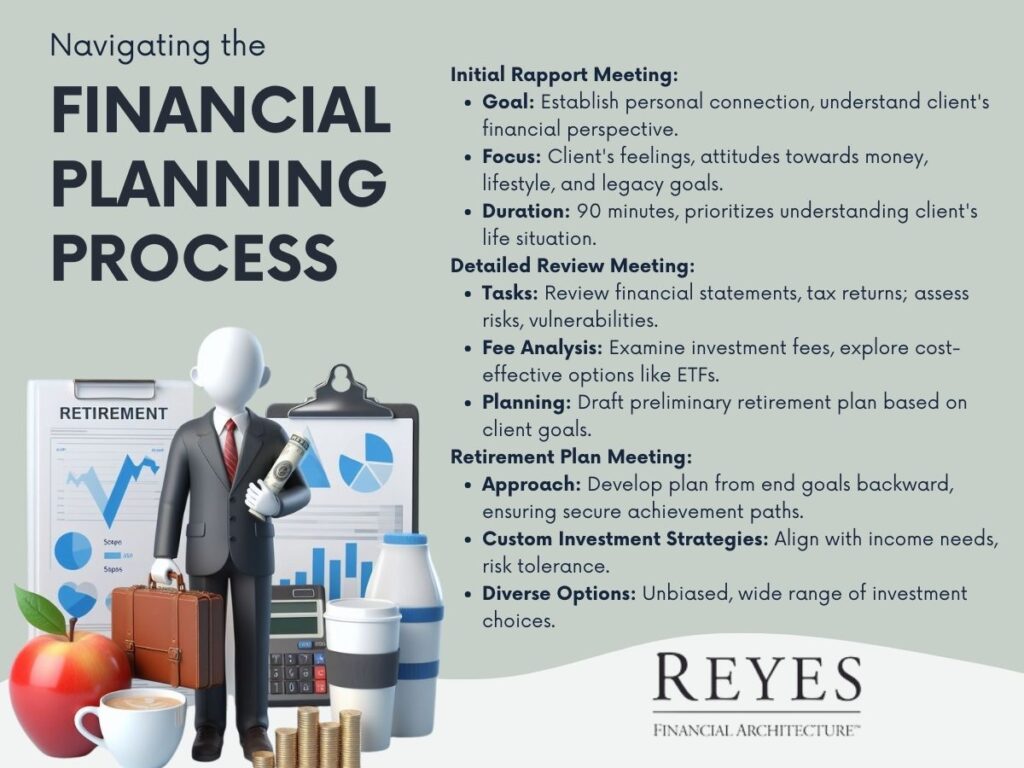
The journey begins with an initial meeting, where the primary objective is to establish a personal connection. This stage is crucial for:
The second meeting delves into the specifics of the client’s financial situation. This includes:
In the final meeting, the focus shifts to comprehensive retirement planning:
A personalized financial plan is imperative because of the unique nature of each individual's financial situation. The key elements of this approach include:
A skilled financial advisor plays several critical roles in this process:
The three-meeting financial planning process is a testament to the importance of a tailored, client-centric approach. It emphasizes the need to understand each client's unique financial narrative, align investment strategies with individual goals, and prioritize educating clients for informed decision-making. This process not only helps in building a robust financial plan but also fosters a deeper understanding and trust between the advisor and the client, paving the way for financial security and a successful retirement.
Retirement planning is an essential aspect of financial management, yet it remains a challenging endeavor for many. Understanding the nuances of investment, market trends, and effective strategies is vital for a secure retirement.
This blog post explores key principles and strategies to help individuals build a robust retirement plan, emphasizing risk management and financial efficiency.
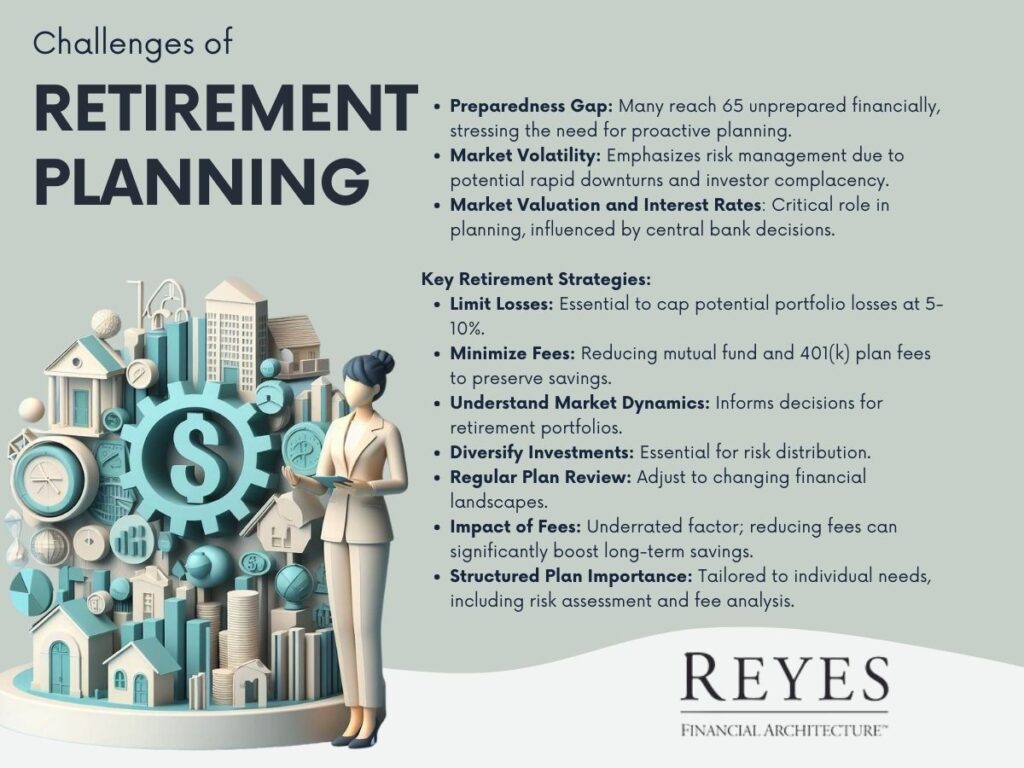
Statistics indicate a concerning trend: a large percentage of individuals reach the age of 65 without adequate financial resources, often relying on family or government support. This underscores the importance of proactive and strategic retirement planning, focusing on creating a guaranteed lifetime income.
Market volatility is a significant factor in retirement planning. Historical trends show substantial market downturns can occur rapidly, highlighting the need for a risk-aware investment approach. As time passes since major financial crises, there's a risk of investor complacency. Acknowledging and planning for potential market fluctuations is crucial in safeguarding retirement funds.
The valuation of the market, often influenced by decisions made by central banks like the Federal Reserve, especially regarding interest rates, plays a critical role in retirement planning. Overvaluation of the market and fluctuating earnings projections can impact investment strategies. Recognizing these factors can aid in making informed decisions for retirement portfolios.
To achieve a secure retirement, certain strategies and principles should be considered:
Additional strategies include understanding market dynamics, diversifying investments, and regularly reviewing and adjusting financial plans.
One often overlooked aspect of retirement planning is the impact of fees on long-term savings. Many individuals are unaware of the fees they incur, especially in investment products like mutual funds and employer-sponsored plans such as 401(k)s. Reducing these fees can lead to significant savings over time.
A structured retirement plan is critical. It should include a thorough risk assessment, an analysis of fees, and a comprehensive strategy tailored to individual needs and goals. A well-constructed plan provides clarity and a roadmap for achieving retirement objectives.
Effective retirement planning requires a multifaceted approach, balancing risk management, financial efficiency, and a deep understanding of market conditions. By adopting key strategies and maintaining a focus on long-term goals, individuals can enhance their chances of a financially secure retirement.
The process involves regular review and adaptation to changing circumstances, ensuring that retirement funds are not only accumulated but also protected and optimized for the long haul.
Planning for retirement requires a keen understanding of market trends, interest rates, and other economic indicators. Here, we explore strategies and insights for securing a financially stable retirement, even in the face of potential economic downturns.
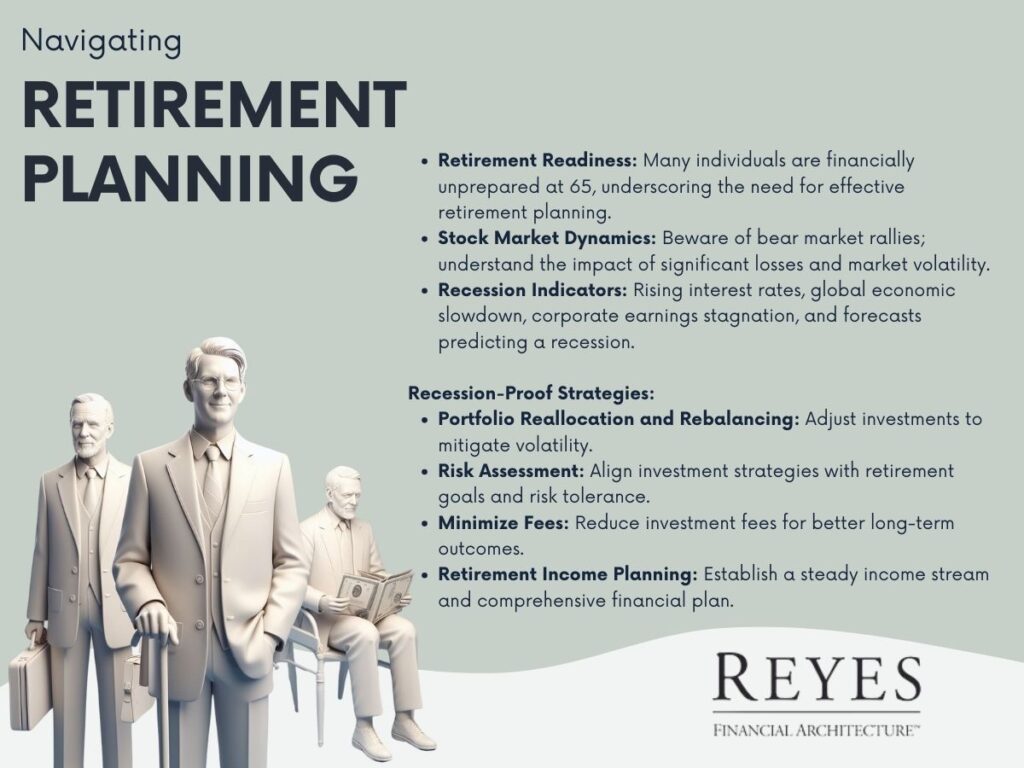
A significant number of individuals reach the age of 65 unprepared financially, often relying on family support or government assistance. This highlights the critical need for effective financial planning to ensure a consistent income throughout retirement.
An important aspect of stock market behavior to recognize is the phenomenon of bear market rallies. These are substantial yet typically temporary recoveries in a declining market, which can mislead investors into believing in the market's stability. The mathematical reality is that a stock falling by 50% and then gaining 50% is still 25% below its original value. This underscores the need to be wary of significant losses and to approach investment decisions with caution.
Several indicators suggest the possibility of an economic recession:
To reduce risks associated with economic downturns, several proactive measures are recommended:
Having a solid retirement plan can provide confidence, even during market downturns, preventing panic and impulsive decision-making.
The complexities of retirement planning, especially in uncertain economic times, make professional advice invaluable. Tailored retirement strategies, responsive to individual needs and economic conditions, are critical for achieving financial security in retirement.
Achieving a secure retirement amidst economic uncertainties is challenging but attainable with the right approach. Being informed about market dynamics, recognizing economic indicators, and taking strategic actions to protect retirement funds are integral to successful retirement planning. These insights offer guidance for individuals seeking to build a resilient and secure retirement plan, regardless of economic fluctuations.
Check out this video to get a better understanding of one of the biggest stocks in the market and what influence it is currently carrying out.
In the ever-evolving landscape of the stock market, technology stocks stand out for their potential for high growth and significant volatility. Among these, Apple Inc. has recently drawn attention due to its dramatic shift in market valuation.
Once a titan in the trillion-dollar club, Apple experienced a substantial decline in its market capitalization, shedding light on the unpredictable nature of tech investments. This article delves into the factors behind Apple's market performance, the broader implications for investors, and the importance of strategic planning in navigating the complex and often turbulent world of technology stocks.
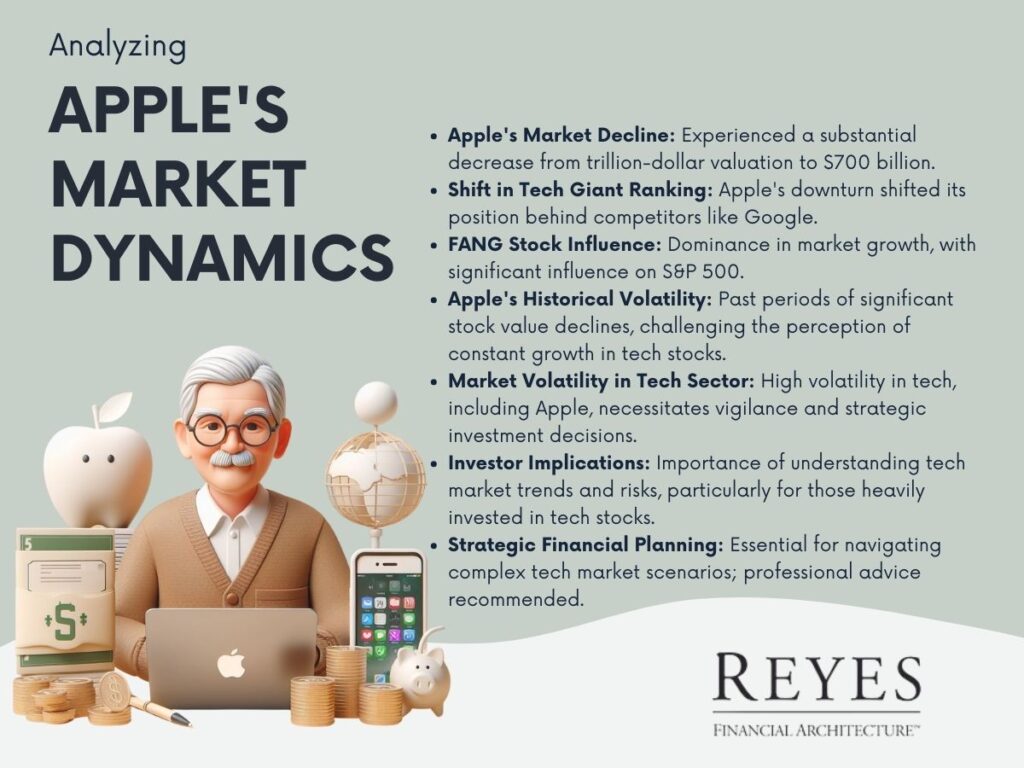
In a notable shift within the tech industry, Apple Inc. experienced a substantial decrease in its market capitalization. Once a company with a trillion-dollar valuation, Apple saw its worth plummet to around $700 billion. This decline of over $300 billion in market capitalization is not just a numerical figure; it's indicative of broader market trends and investor sentiments.
Previously competing for the top spot among global companies, this downturn relegated Apple to a lower position, behind other tech giants like Google. This change is a stark reminder of the volatility and competitiveness inherent in the technology sector, where companies continuously compete for market dominance.
FANG stocks, an acronym for Facebook, Apple, Netflix, and Google, have significantly influenced market dynamics. Particularly in 2018, these companies were responsible for 70% of the total gains in the S&P 500. This dominance by a small group of technology companies shows a considerable concentration of market growth within a select segment of the stock market.
The recent downturn in Apple's stock value is not an isolated incident. The company faced similar reductions in 2015-2016 and 2012-2013, with stock value declines of 33% and 42%, respectively. These instances highlight a pattern of volatility in Apple's stock, challenging the notion that tech stocks are always on a rising trajectory.
The technology sector, and companies like Apple in particular, often exhibit high levels of market volatility. This can lead to significant fluctuations, including notable market rallies and downturns. Investors are advised to be vigilant during these periods, potentially using them as opportunities for strategic portfolio adjustments and the selling of securities.
The fluctuations in companies like Apple underscore the risks inherent in stock market investment, especially in the volatile tech sector. For investors with substantial exposure to tech stocks or related indices, understanding market trends and the company's historical performance is crucial. It's important to be aware of these risks and to make informed decisions based on the current economic environment and individual investment objectives.
Given these market dynamics, effective financial planning is essential. Investors should consider seeking professional advice to navigate complex market scenarios. An informed approach, combining real-time market analysis with a clear understanding of individual goals, can aid in developing a balanced and risk-adjusted investment portfolio.
The decline in Apple's market value serves as a pertinent example of the challenges and volatility in tech sector investments. Despite the impressive performance of FANG stocks, they are not immune to market fluctuations. Investors should remain informed, strategic, and cautious in their investment approaches, especially in the rapidly evolving tech industry. Professional financial guidance and a keen awareness of market trends are key to navigating these complexities and achieving long-term investment success.